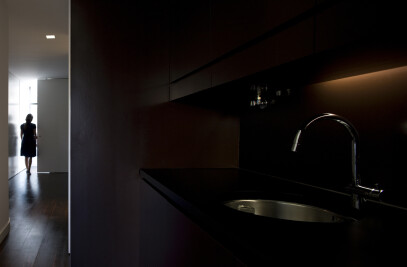A new adega for the Azores Wine Company is located within the Unesco World Heritage vineyard landscape of Pico Island, one of the nine islands that form the mid-Atlantic, Azorean archipelago. In a manner not dissimilar to the island’s traditional wineries - small-scale structures located along the coast where wine was produced and family and friends were welcomed – the building combines spaces of production with those of conviviality and extended domesticity, within a single coherent form. Recalling the cloistered courtyard typologies of the religious institutions, Pico’s most significant historical structures and the communities for whom wine was first produced, the building’s simple, geometrical volume defines a garden at its centre. Enclosed by a covered perimeter, this intimate exterior space counterpoints the scale of the landscape beyond.

The precision of the plan form is adjusted in section to follow the rugged terrain, which rises from the rocky, windswept coastline to the cone of Pico mountain, the volcano that dominates the island. The changing relationship between topography and horizon is experienced in the movement around the reduced form of this cloister like edge, where a continuously ramping, exterior path climbs from within the shelter of the bounding wall to address the landscape. Along the way it interacts with a sequence of production spaces, which occupy three of the sides. Arranged as an enfilade, these commence in a series of barrel rooms that step up the slope from the space of entry to arrive at tank rooms for red and white wine and finally culminate in a tasting room that overlooks an upper terrace. Below it, a house for the owners culminates a sequence of five guestrooms. These occupy the lower, Northern edge of the courtyard, set against the linear edge of a water retention pool.

Looking across their roofscape, the terrace offers an expansive prospect, encompassing the intense latticework of lava stone walls, known as currais, that protect the vines. Beyond them, the neighbouring islands of Faial and São Jorge are set within the wide expanse of the Atlantic Ocean, while turning back South, the edge of the roof frames the cone of the volcano itself. This concrete edge draws a continuous and rigorous line within the landscape, drawing together the contrasting material character of interior and exterior. Below it, the outer wall of the building is of dry stacked stone, recovered from the terrain of the vineyard as spolia and merging its form almost seamlessly into the wider network of walls. Within, the abstraction of the white plaster surfaces refers to the manner in which the most important historical buildings on the island were distinguished from their agricultural and industrial neighbours.

In this way, an industrial building of a new scale is situated within a remarkable and highly sensitive context, in a way which allows it to take its place within, and recede into, the intricacies of the manmade landscape it serves. The first significant production facility constructed in more than a century, the adega allows the vineyards to regain their true purpose and in doing so, commences a process of remaking a wine region. One which was once of worldwide significance, but has long been forgotten.
Team:
Client: Azores Wine Company
Architect: SAMI-arquitectos . Inês Vieira da Silva. Miguel Vieira with DRDH . Daniel Rosbottom . David Howarth
Project team: João do Vale Martins, João Completo, Andreia Luís, João de Brito Oliveira - arquitectos
Structural Engineer: Betar. Miguel Villar, Leonor Antunes
Mechanical Engineer, Natural Ventilation design / Condicionamento Acústico, Comportamento: NaturalWorks - Engineering Consultants . Guilherme Carrilho da Graça, Pedro Maria Paredes, Maria Malato Lerer
Water and Sanitation: Campo d'Água, Engenharia e Gestão Lda . Marta Azevedo
Electrical Engineer: NaturalWorks - Engineering Consultants . Tiago Costa Oliveira
Fire Safety: ETU Fire Safety Consultants - Cidália Worm
Installation and gas equipment: Horácio Carvalho
Adega Stainless steel equipment and products: Equiproin
Design de Interiores: Ana Trancoso
Construction Company: Marques, S.A.


































































